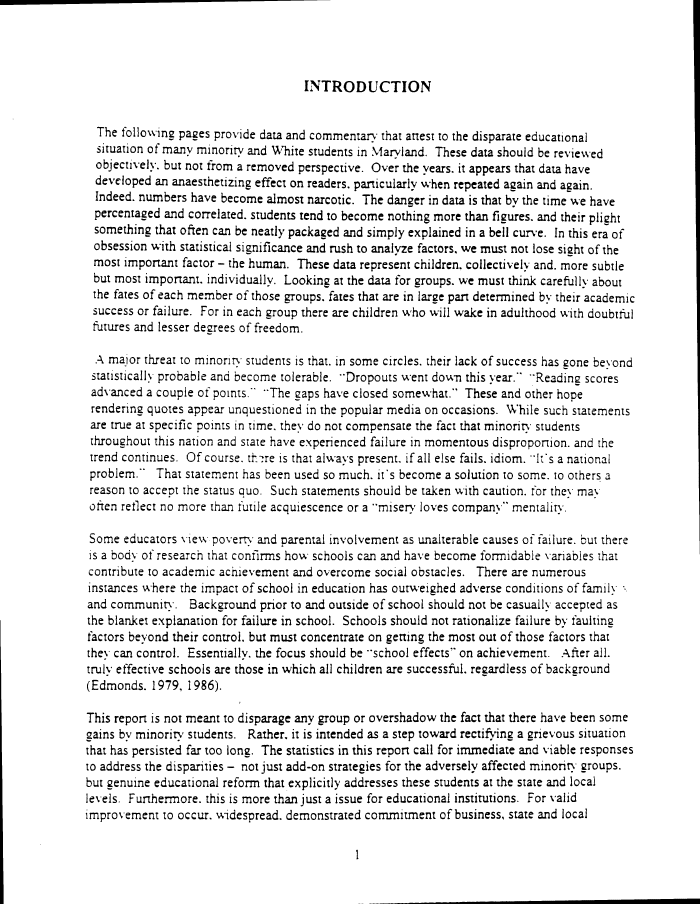 |
||||
|
TASK FORCE TO STUDY THE HISTORY AND LEGACY OF SLAVERY IN MARYLAND (Final Report) 1999/12/31 MdHR 991422 MdHR 991422, Image No: 180 Print image (94K) |
 |
||||
|
TASK FORCE TO STUDY THE HISTORY AND LEGACY OF SLAVERY IN MARYLAND (Final Report) 1999/12/31 MdHR 991422 MdHR 991422, Image No: 180 Print image (94K) |
| INTRODUCTION The following pages provide data and commentary that attest to the disparate educational situation of many minority and White students in Maryland. These data should be reviewed objectively, but not from a removed perspective. Over the years, it appears that data have developed an anaesthetizing effect on readers, particularly when repeated again and again. Indeed, numbers have become almost narcotic. The danger in data is that by the time we have percentaged and correlated, students tend to become nothing more than figures, and their plight something that often can be neatly packaged and simply explained in a bell curve. In this era of obsession with statistical significance and rush to analyze factors, we must not lose sight of the most important factor - the human. These data represent children, collectively and. more subtle but most important, individually. Looking at the data for groups, we must think carefully about the fates of each member of those groups, fates that are in large pan determined by their academic success or failure. For in each group there are children who will wake in adulthood with doubtful futures and lesser degrees of freedom. A major threat to minority students is that, in some circles, iheir lack of success has gone beyond statistically probable and become tolerable. "Dropouts went down this year." "Reading scores advanced a couple of points." "The gaps have closed somewhat." These and other hope rendering quotes appear unquestioned in the popular media on occasions. While such statements are true at specific points in time, they do not compensate the fact that minority students throughout this nation and state have experienced failure in momentous disproportion, and the trend continues. Of course, thire is that always present, if all else fails, idiom. "It's a national problem." That statement has been used so much, it's become a solution to some. 10 others a reason to accept the status quo. Such statements should be taken with caution, for they may often reflect no more than futile acquiescence or a "misery loves company" memaliry. Some educators view-poverty and parental involvement as unalterable causes of failure, but there is a body of research that confirms how schools can and have become formidable variables thai contribute to academic achievement and overcome social obstacles. There are numerous instances where the impact of school in education has outweighed adverse conditions of family -and community. Background prior to and outside of school should not be casually accepted as the blanket explanation for failure in school. Schools should not rationalize failure by faulting factors beyond their control, but must concentrate on getting the most out of those factors that they can control. Essentially, the focus should be "school effects'" on achievement. After all. truly effective schools are those in which all children are successful, regardless of background (Edmonds. 1979, 1986). This report is not meant to disparage any group or overshadow the fact that there have been some gains by minority students. Rather, it is intended as a step toward rectifying a grievous situation that has persisted far too long. The statistics in this report call for immediate and viable responses to address the disparities - not just add-on strategies for the adversely affected minority groups, but genuine educational reform that explicitly addresses these students at the state and local levels. Furthermore, this is more than just a issue for educational institutions. For valid improvement to occur, widespread, demonstrated commitment of business, state and local 1 |